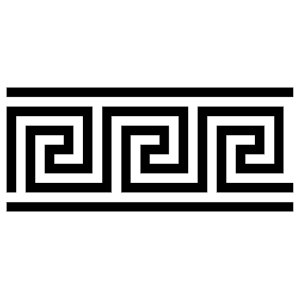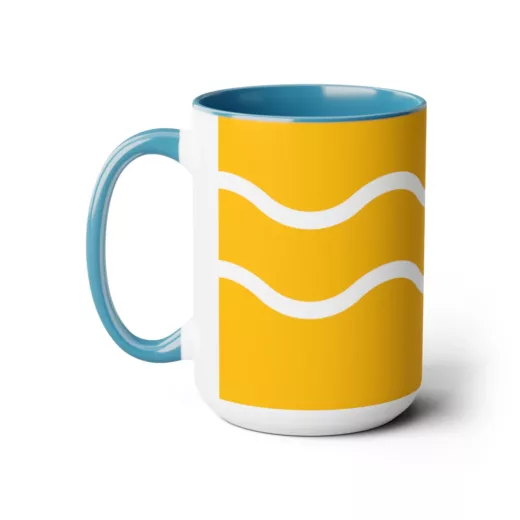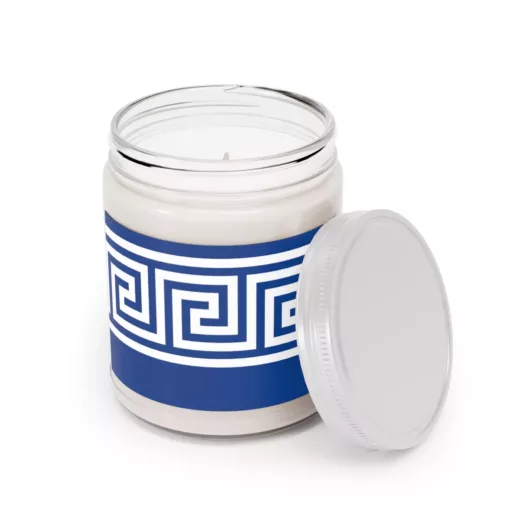From the magnificent temples of ancient Greece to the sleek and contemporary interiors of modern design, the Greek Key pattern has made a lasting impact on the world of art and decor.
The Greek Key, also known as the meander or fret pattern, consists of a continuous line that twists and turns, creating an interlocking geometric motif. Its origins can be traced back to ancient Greek architecture, where it adorned the friezes, borders, and pottery of prominent structures. It represents infinity and the eternal flow of life.
In modern design, the Greek Key pattern continues to captivate with its timeless elegance and versatility. From furniture and textiles to jewelry and accessories. Its symmetrical and rhythmic design creates a sense of harmony and balance, making it a popular choice for decorators and fashion enthusiasts.
In this article, we will explore the history of the Greek Key pattern and share tips on how to match it with your design. There are endless ways to create a modern and timeless look based on the classical thought.
History and origin of the meander pattern
The Greek Key pattern is one of the most recognizable motifs in ancient Greek art and architecture. Greeks used it as a decorative element in pottery, jewelry, and architecture. Carved on temple borders represented unity and infinity.
No one knows how the it came to life. Even before the Hellenistic era, the motif was already being used.
The name originates from the Ancient Greek river Meander. The river flowed eastward from the ancient Greek town of Miletus, now Milet, Turkey.
The famous Greek geographer, Strabo, described Meander as:
…its course is so exceedingly winding that everything winding is called meandering
Strabo, Geography, Book 12 Chapter 8 Section 15.
This poetic observation perfectly captures the essence of the river that inspired the creation of the meander.
The meander pattern survived the test of time, adopted by the Romans, who used it in their own art and architecture. Later, incorporated by the Byzantine Empire into the design of their churches and other buildings. The Greek Key pattern continued to be used throughout the Middle Ages and the Renaissance, and it remains a popular design element today.

Symbolic meaning of the Greek Key pattern
The Greek Key pattern holds a deep and diverse significance. Its modern meaning refers to a purposeless wandering – a directionless journey, devoid of any goal. It embodies the concept of meandering, where the focus is on enjoying the journey rather than reaching a specific destination.
This continuous line that twists and turns visualises the eternal flow of life. Its iconic design also holds a deeper meaning, symbolizing the everlasting bond between two people. It is no wonder that Greek Key has become a favored choice for wedding rings and romantic gifts. Moreover, the interlocking pattern can represent various elements, such as waves, the four compass points, and the four seasons, adding a touch of versatility and symbolism to this timeless design.

Greek historian of religion Michael Kalopoulos discovered that the meandros symbolized a distinct handgrip used in the ancient Greek wrestling style known as pankration. However, the symbol went beyond its practical significance and held a metaphysical meaning; it also embodied the heroic and resilient spirit that epitomized the Greeks.
Design elements of the Greek Key pattern
The design comprises multiple lines arranged in a recurring pattern that bears a resemblance to a key. The most common shape used in the Greek Key is the square, which is repeated to create the continuous line. However, there are versions, including rectangles, triangles, and diamonds.

Meander adopts to various materials, including stone, metal, and fabric. We can carve into hard substances, or we can weave it into fabric using a variety of techniques.
Although typically linked to classical Greek art and architecture, these patterns had a significant impact on modern textiles.
How the Greek Key pattern can be used in modern design
The Greek Key has become a popular choice for adding visual interest and sophistication to modern design. Its simplicity enables a variety of ways for its application. From subtle accents to bold statement pieces. From buildings and furniture to personal accessories and jewelry.
One way to incorporate the Greek Key into your modern design is to use it as a border design. The repetitive nature of the pattern creates an aesthetic, harmonious flow. It captivates the gaze along the edges and highlights the architectural features. This is really effective when used around doorways and windows, as it highlights these elements and adds a touch of elegance.
Another way to incorporate the pattern into your design is by using it as a wallpaper or wall decal. Whether you want to create a subtle accent wall or make a bold statement, this pattern can add a unique touch to your space. By applying it to your walls, you can easily transform the atmosphere and bring a sense of style to your room.
We can find meander on surfaces that are not flat. Creatively incorporated into furniture, adds an extra touch of elegance and visual appeal. Found on the legs of a table or the arms of a chair, one can effortlessly infuse sophistication into any space.
Its versatility expands beyond furniture. You can apply it on various accessories, including pillows and curtains, to unify the room and establish a harmonious ambiance.
The meander has an undeniable power to elevate any outfit with its boldness and touch of sophistication. This timeless pattern effortlessly adds a sense of elegance to watches, jewelry, and handbags. Whether it’s a sleek timepiece or a statement necklace, the Greek Key brings a sense of luxury and timeless beauty to any accessory it adorns.
Tips for using the Greek Key pattern effectively
When using the Greek Key in your modern design, it’s important to keep a few things in mind. First, consider the scale of the pattern. A large pattern can be overwhelming, while a small pattern may not have enough impact. It’s also important to consider the color of the pattern. A bold pattern in a bright color may be too much, while a subtle pattern in a neutral color may not have enough impact.
Blue and white tones often characterized Greek color palettes.
The colors reflect ancient Greek culture and the climate of Greece. The choice of blue and white tones evokes a sense of tranquility and harmony, reminiscent of the Mediterranean sea and clear skies.
Another palette comprises orange and black, particularly seen on ancient Greek pottery. Orange and black adds a bold and dramatic touch, creating a striking contrast that captivates the viewer. The Greek color palettes highlight the artistic mastery and timeless beauty of this ancient civilization.
Another tip for using the Greek Key effectively is to mix it with other shapes and textures.
Finally, it is important to consider the overall style of the space. The pattern adds sophistication to a modern space or a touch of classic elegance to a traditional space.
Conclusion
The Greek Key pattern has stood the test of time and continues to captivate with its timeless elegance and cultural significance. From ancient Greece to modern design, this iconic pattern has left its mark on the world of art and decor.
Its symbolism and meaning, representing infinity and the eternal flow of life, make it a powerful and meaningful design element. Its symmetrical and rhythmic design creates a sense of harmony and balance.
Whether you choose to incorporate the Greek Key pattern into your home decor or your personal style, it is sure to make a lasting impression. Its enduring legacy is a testament to its beauty and significance, reminding us of the rich history and spirit of ancient Greece.
To sum up:
- meander is a symbol of infinity, unity, and continuity.
- its name comes from the shape of Meander river
- symbolizes heroic and resilient Greek spirit
- timeless design, easily applied as a repetitive pattern
- an ideal choice for a framing ornament.







